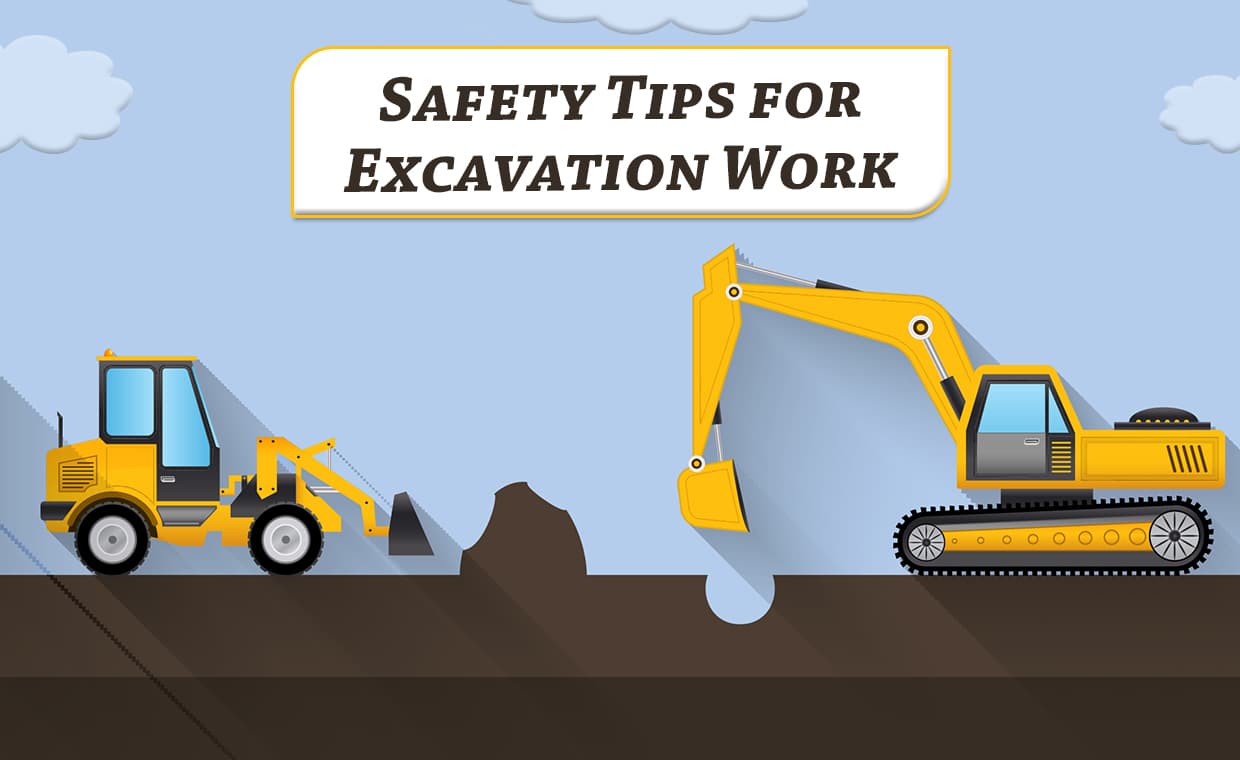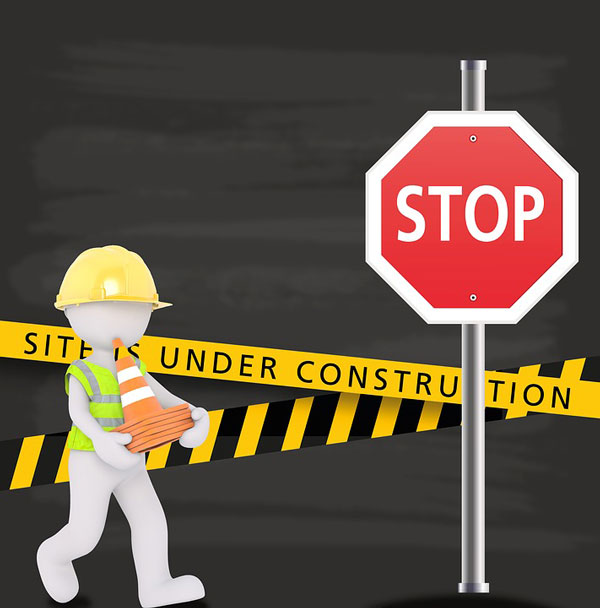
Fast work while maintaining high-quality standard are the buzz word of this century. However, in the rush to attain these objectives, work place safety is often ignored or compromised. Safety measures are MUST while considering time, speed and efficiency of work.
Excavation is the first activity that is carried out at any construction site. Manual excavation is done with the use of pickaxe and shovel. However, excavation methods are fast becoming mechanised.
Most places today provide basement parking, sometimes even two basement parking. In order to provide this facility, excavation needs to be more than seven to nine meters, and this demands high levels of care and precautions in and around the excavation area.
Excavation work, as such, appears simple. Use of earth-moving machinery has reduced manual labour and work time to a considerable extent. Nevertheless, it is as hazardous as any other construction operation. About 10 % of the total number of on-site accidents occur during excavation work. Therefore, due attention is required to comply with safety measures.
(a) Why Accidents Happen?
01. Most accidents occur due to collapse of weak layer of soil or because of drying/shrinkage of soil due to loss of moisture.
02. Accidents also happen when the excavation is carried out beyond the depth of foundations of the existing buildings nearby. This exposes the foundations of existing buildings, and with no margins left, the soil starts caving in, leading to major disasters.

03. While excavating you may also come across utility lines like electrical cables or gas lines. If you are not cautious enough, you may hit them leading to big problems.
(b) Pre-Excavation Planning

04. Obtain the necessary drawings and clearly mark out the location of temporary structures, storage area and the actual construction site

05. Provide fencing, gates, access roads, water and electrical power supply lines, drinking water and sanitary facilities, and site office
06. Locate previously installed underground utilities. Divert them temporarily or permanently, or provide for their protection during the progress of the work
07. Obtain information about the sub-soil strata and underground water table level well in advance, including depth and area of excavation
08. Obtain information about the estimated quantity of the excavation, and the manpower, machinery that can be deployed
09. Decide the stage- by stage completion dates for various structures
10. Make sure all legal permissions have been obtained before starting the excavation
11. Ensure that the necessary safety appliances, personal protection equipment and First Aid facility are available on site
(c) Standard Safe Work Method
12. Once all the above-mentioned information is collected, the work-method is decided upon and incorporated in the project. A specific safety plan and manual should be created for constant guidance of the site staff. The excavation team should be specially briefed about the same through a training session
13. The supervisor should include the work method and safety manual in his tool box briefing sessions, and perform regular rounds to ensure that the excavation work is carried out appropriately as per the requirements of the location and type of soil
There are four types of locations:
(I) Open excavation work for structures at ground level for individual footings
(II) Open excavation work for structures at ground level for raft/basement, etc.
(III) Excavation work in or near waterbodies i.e. near lakes, rivers, etc.
(IV) Excavation work adjacent to existing buildings
(V) Underground excavation work for structures like tunnel and power house
(d) Requisites for Implementing Safe Work Method
14. The team of workers should be physically fit, and should have technical skills, trade-skills, safety awareness, safety skills, and human relation skills.
15. The machinery, plant and equipment, the appliances and tools should be in a well-maintained condition. The operators should have a valid license, and the guard and slingers should be skilled and experienced.
16. The supervisor should be competent, that is, he should have the qualification and appropriate training, experience and also authority from the employer. He should be well versed in the documentation system.
(e) Hazards and Safety Measure
Hazards at construction sites, are of two types:
- Construction activity-related hazards: The relevant safety measures are included in the safety manual
- Site-related or location-related hazards: The relevant safety measures are as follows:
(I) Proper use of personal protective equipment
(II) Good and effective housekeeping system
(III) Effective training to all site staff regarding emergency action plans
(IV) Training in emergency lifesaving aid and first aid to injured people
(f) Precautions
17. When you excavate a large area or a raft foundation or if the basement and depth of excavation is more than 3.0 to 4.0 m in loose soil, it is compulsory to provide benches that are 1.0 to 1.5 m wide or steps at every 1.5 to 2.5 m depth depending upon the type of soil, so that the earth does not collapse
18. Always maintain sufficient margin from the adjacent property or compound wall, so that any collapse of soil does not endanger the structure. If the soil is bad and the depth of excavation is more, always put benches/steps. Even after benching, avoid the temptation to excavate the whole site. Instead, do it in phases so that there is less risk. If no margin is available, diaphragm wall is the option to be explored
19. Never start excavation work unless your ‘cut’ steel is ready and you have adequate manpower for shutter, steel and concrete work
20. Keep away all equipment from the site that vibrates heavily like mixture machine, lift, etc.
21. Keep all safety equipment, tools, etc. available on the site and see that they are properly used
22. Maintain proper barricading so that stray animals do no fall into the excavation area
23. Provide a proper path from where one can come up quickly and easily on ground in case of emergency
(g) Excavation Adjacent to Existing Building
In a crowded city you may often have to excavate adjacent to an existing building, which may even be a high-rise. In such cases, maintain the following precautions:

24. Do not excavate beyond the depth of foundation of the existing building. In case you have to do it for a few centimeters, do not keep it exposed for more than one working day and complete sand filling, PCC etc., as soon as you reach the full depth of excavation. Complete concreting of footing and column on emergency basis and start refilling within 24-36 hours without losing time
25. Never excavate more than one pit at a time. Carry out excavation for columns, one column at a time. Start excavation of the next pit only after you have completely refilled the pit excavated up to plinth and with adequate watering
26. Never expose large area at a time, so always excavate alternate columns at a time. i.e. Never do, excavation for two adjacent columns at a time.
27. In case the existing building is a load bearing one and the depth of foundation is not too much, you will have to be extremely cautious. Never excavate more than one pit at a time.
28. Always keep stock of sand or earth at site, so that in case of emergency you can immediately fill and save major disasters
29. If the adjacent house has an old wooden frame, provide adequate propping with steel props under the proper guidance of a structural engineer
30. Do shoring and strutting when the excavated soil consists of trenches or when working with black cotton soil or silt
31. Spray bentonite over the wet, excavated soil. This will hold the excavated soil for a few days during which time you can complete the foundation, column and refilling work
These are very important precautions and should not be avoided in the name of cost saving as safety of workers is of paramount importance. Do not start excavation just before or during monsoon. And never start work without adequate manpower.
(h) Excavation Near River, Lakes & Waterbodies
If the excavation foundation is adjacent to a river, lake or any waterbody, start work only after careful planning.
32. Always assure that you provide margin as required under law
33. If it is a big river, decide the depth of foundation in consultation with a geotechnical engineer as well as a structural engineer, based on the scour depth of the river, type of riverbed soil and highest flood level
34. Plan for best possible river and embankment protection
35. Make sure that the water does not rush from the waterbody. Maintain earth which act as bunds
36. Avoid excavation during monsoon, particularly in rivers where there are possibilities of flash flood
37. Don’t do work nor decide the depth of foundation without proper geotechnical investigation.
(i) Supervision: Inspection and Documentation
(I) Supervision
38. It is the statutory responsibility of the employer to provide constant and adequate supervision.
39. Under the employer’s guidance, the project manager/supervisor is the key person to ensure that the work is carried out with due regard for quality, progress, estimate-cost and, above all, safety.
40. The project manager/supervisor should fully utilize the guidance of the safety officer. He should keep up the skill level of the workers by identifying and fulfilling their training needs.
41. He should also keep them motivated by providing a work environment which satisfies their human needs. He should remember, a participative and persuasive attitude is more faithful than a punitive attitude for maintaining safety and discipline at site.
(II) Inspection and Documentation

42. For daily supervision work, the supervisor should maintain a daily report. It should contain the particulars of all the technical aspects of the excavation work, the safety status of the site and the actions taken to ensure safety.
43. A weekly inspection register of excavation work is mandatory. This record and documentation are important to prove that you have taken all practical steps to prevent accidents, in case there are any legal requirements or emergencies.
44. According to ‘IS 3764: 1992’ Inspection shall be carried out after heavy rain or storms to ensure safe working conditions.
(j) Back Filling

45. The excavated pit or area should be filled up to the ground level as soon as the constructed structure permits back filling
46. Before back filling ensure that all underground utilities are properly joined/supported and need no further protection
47. 60 cm thick rubble/gravel packing should be provided behind retaining walls, before back filling, to permit drainage of water through the weep holes in the retaining wall
48. The back-filling material should be spread in layers, watered and consolidated, to avoid settlement at a later date. The ground may, thereafter, be turfed or paved
49. In case of large open excavation work like open cast mines, back filling should not to be done. The whole periphery should be fenced as per ‘miner rules’
50. In collieries, after completing the mining operation, the tunnels should be packed with sand
51. As per ‘IBC (international building code)’ the excavation outside the foundation shall be backfilled with soil that is free of organic material, construction debris, cobbles and boulders or a controlled low-strength material (CLSM). The backfill shall be placed in lifts and compacted, in a manner that does not damage the foundation or the waterproofing or damp proofing material
Summary
Excavation work is a very risky operation. But it can be made safe by creating an awareness about the hazards and the precautions that should be taken, and a careful management of the entire process. The work should be carefully planned and executed. Ensure that, equipment and materials are available on site before work begins. Competent (skilled) supervisors/project managers should direct the work and investigate it daily to avoid risks and accidents. Above all, every detail should be documented.
Also Read:
Dewatering Methods During Excavation in Waterlogged Area
Various Types of Excavation Equipment Use on Construction Site
Image Courtesy: Image 2, Image 5, Image 6 – alzillazgaming, Image 7


































